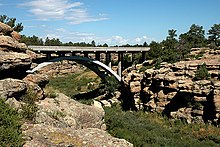
Larimer County is a county located in the U.S. state of Colorado. As of the 2020 census, the population was 359,066. The county seat and most populous city is Fort Collins. The county was named for William Larimer, Jr., the founder of Denver.

Estes Park is a statutory town in Larimer County, Colorado, United States. The town population was 5,904 at the 2020 United States Census. Estes Park is a part of the Fort Collins, CO Metropolitan Statistical Area and the Front Range Urban Corridor. A popular summer resort and the location of the headquarters for Rocky Mountain National Park, Estes Park lies along the Big Thompson River. Landmarks include The Stanley Hotel and The Baldpate Inn. The town overlooks Lake Estes and Olympus Dam.
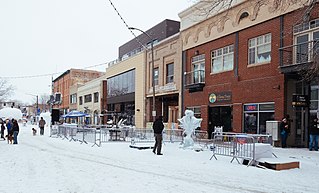
Loveland is the home rule municipality that is the second most populous municipality in Larimer County, Colorado, United States. Loveland is situated 46 miles (74 km) north of the Colorado State Capitol in Denver and is the 14th most populous city in Colorado. As of the 2020 census the population of Loveland was 76,378. The city forms part of the Fort Collins-Loveland Metropolitan Statistical Area and the Front Range Urban Corridor. The city's public schools are part of the Thompson R2-J School District.
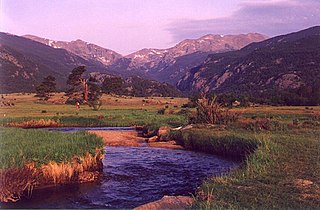
The Big Thompson River is a tributary of the South Platte River, approximately 78 miles (126 km) long, in the U.S. state of Colorado. Originating in Forest Canyon in Rocky Mountain National Park, the river flows into Lake Estes in the town of Estes Park and then through Big Thompson Canyon. It includes four crossings/bridges which are listed on the U.S. National Register of Historic Places.

Curecanti National Recreation Area is a National Park Service unit located on the Gunnison River in western Colorado. Established in 1965, Curecanti National Recreation Area is responsible for developing and managing recreational facilities on three reservoirs, Blue Mesa Reservoir, Morrow Point Reservoir and Crystal Reservoir, constructed on the upper Gunnison River in the 1960s by the U.S. Bureau of Reclamation to better utilize the vital waters of the Colorado River and its major tributaries. A popular destination for boating and fishing, Curecanti offers visitors two marinas, traditional and group campgrounds, hiking trails, boat launches, and boat-in campsites. The state's premiere lake trout and Kokanee salmon fisheries, Curecanti is a popular destination for boating and fishing, and is also a popular area for ice-fishing in the winter months.

U.S. Route 50 (US 50) is a part of the U.S. Highway System that travels from West Sacramento, California, to Ocean City, Maryland. In the U.S. state of Colorado, US 50 is a major highway crossing through the lower midsection of the state. It connects the Western Slope with the lower Front Range. The highway serves the areas of Pueblo and Grand Junction as well as many other smaller areas along its corridor. The long-term project to widen the highway from two lanes to a four lane expressway between Grand Junction and Montrose was completed in January 2005. Only about 25% of the remainder of highway 50 in Colorado is four lane highway.

The Pueblo Bridge Co. is a firm that built a large number of bridges in the United States. Several are listed on the U.S. National Register of Historic Places.

The Missouri Valley Bridge & Iron Co., also known as Missouri Valley Bridge Company, was an engineering, construction, and steel fabrication firm that operated through the late nineteenth and most of the twentieth centuries. It was based in Leavenworth, Kansas, with a WWII facility in Evansville, Indiana.

Daniel B. Luten also known as Daniel Benjamin Luten was an American bridge builder and engineer based in Indianapolis, Indiana.
Four historic bridges on the Big Thompson River in Larimer County, Colorado survived its flood of 1976, but since have lost most of their historic integrity. They were built in 1933 and 1937. All four were listed on the National Register of Historic Places in 2002, and two were delisted in 2010.

Midwest Steel & Iron Works was a metal fabrication company based in Denver, Colorado. Founded in 1893, the company was known for a time as the Jackson-Richter Iron Works. The company was one of the oldest and largest metal fabricators in Denver. The company built both structural and ornamental components for structures throughout Colorado, Wyoming, and New Mexico. The company's headquarters on Larimer Street in Denver includes an Art Deco office building and consists of a four-building complex that is itself considered a historic industrial site. The complex served as the company's headquarters from 1923 to 1983.

The Virginia Bridge & Iron Co., also known as Virginia Bridge Company, was a bridge company based in Roanoke, Virginia.

The Plum Bush Creek Bridge, near Last Chance, Colorado, is a concrete rigid frame bridge that is listed on the National Register of Historic Places. It brings US 36 across Plum Bush Creek and is located at milepost 138.16 of US 36. It was designed by Colorado Department of Highways and built by Peter Kiewit Sons Construction Co. in 1938. It was listed on the National Register of Historic Places (NRHP) in 2002.

The West Plum Bush Creek Bridge, near Last Chance, Colorado, is a historic concrete rigid frame bridge that is listed on the National Register of Historic Places. Like the similar Plum Bush Creek Bridge less than four miles away, it brings U.S. Highway 36 across the Plum Bush Creek. It was designed by the Colorado Department of Highways and built by Peter Kiewit Sons Construction Co. It was listed on the National Register of Historic Places in 2002.
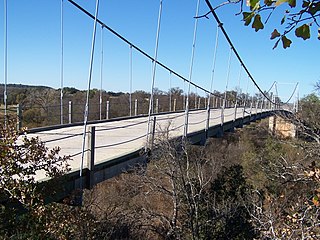
Austin Bridge Company was a bridge company based in Dallas, Texas. It fabricated and built a number of bridges that are listed on the U.S. National Register of Historic Places. It eventually became part of Austin Industries.
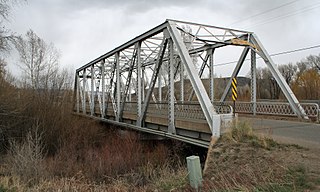
Gunnison River Bridge I and Gunnison River Bridge II are two 129 feet (39 m) long bridges built during 1926–27. They were separately listed on the National Register of Historic Places in 2002.
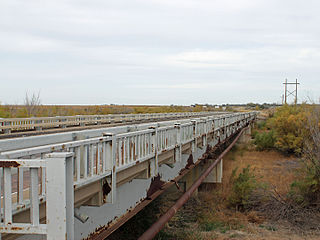
The Granada Bridge, on U.S. Route 385 (US 385) at milepost 97.32 in or near Granada, Colorado. It was listed on the National Register of Historic Places in 2002.
